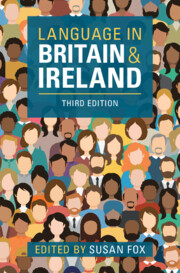Book contents
- Language in Britain and Ireland
- Language in Britain and Ireland
- Copyright page
- Contents
- Figures
- Tables
- Contributors
- Acknowledgements
- Map of Britain and Ireland
- Introduction
- Part I English
- Part II Multilingualism in Britain and Ireland: The Celtic Languages
- Part III Multilingualism in Britain and Ireland: Minority Languages
- 15 Channel Islands French
- 16 South Asian Languages
- 17 Chinese
- 18 Yiddish
- 19 European Immigrant Languages
- 20 Sign Languages in Britain and Ireland
- Part IV Multilingualism: The Development of Urban Contact Varieties
- Part V Applied Sociolinguistic Issues
- Index
- References
20 - Sign Languages in Britain and Ireland
from Part III - Multilingualism in Britain and Ireland: Minority Languages
Published online by Cambridge University Press: 17 October 2024
- Language in Britain and Ireland
- Language in Britain and Ireland
- Copyright page
- Contents
- Figures
- Tables
- Contributors
- Acknowledgements
- Map of Britain and Ireland
- Introduction
- Part I English
- Part II Multilingualism in Britain and Ireland: The Celtic Languages
- Part III Multilingualism in Britain and Ireland: Minority Languages
- 15 Channel Islands French
- 16 South Asian Languages
- 17 Chinese
- 18 Yiddish
- 19 European Immigrant Languages
- 20 Sign Languages in Britain and Ireland
- Part IV Multilingualism: The Development of Urban Contact Varieties
- Part V Applied Sociolinguistic Issues
- Index
- References
Summary
In this chapter, we give a brief overview of the structure, use, and history of British Sign Language and Irish Sign Language, the majority sign languages of the Deaf communities in the United Kingdom and Ireland respectively. After an introduction to the history and social context of each sign language, we present some key features of their grammar, before discussing sociolinguistic variation and change in the two varieties. We close with a discussion of the some of the key applied linguistics dimensions of research into the two sign languages.
Keywords
- Type
- Chapter
- Information
- Language in Britain and Ireland , pp. 439 - 452Publisher: Cambridge University PressPrint publication year: 2024

